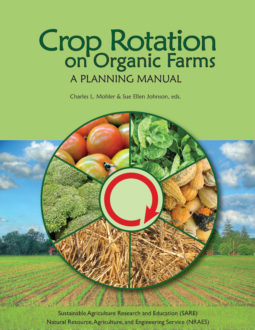When the land has been actively farmed by conventional means, often soil organic matter and soil tilth are low. If the land has been in field crops, the dominant weeds will likely be full-season, spring-germinating annuals like lambsquarters, pigweed, and foxtail. No-till farmed land may have a lot of perennial weeds, as well.
If the farm has a use for forages, beginning the transition with a sod crop like alfalfa or a mixed grass–legume hay has multiple advantages. A few years in sod will build soil structure and organic matter better than any alternative crop will (68). Moreover, annual weeds do not get a chance to go to seed in a mowed hay field, so the density of their seeds in the soil will decline by natural mortality. However, heavy weed seed production may occur during the establishment year of the sod crop, and steps should be taken to prevent this.
Usually, organic growers sow perennial forages with a small grain nurse crop. The nurse crop helps compete with weeds while the forage crop establishes. Winter grains like winter wheat and spelt are better at competing with weeds than spring grains because they are already well established in the spring when the dominant weeds in the field begin to germinate. Also, they are harvested before most of the spring-germinating weeds go to seed. Red clover will establish well if overseeded onto the soil surface in very early spring, while the ground is freezing and thawing (frost seeding). For alfalfa and grasses, planting with a no-till drill is safer. Spring grains and forages can be planted together at the same time. If the farm has a use or market for cereal grain, hay, or green chop, taking the spring grain crop off for one of those uses can prevent most mid-season weed seed production. The young forage crop should be mowed at four to five inches in late summer to further reduce weed seed production.
Often the sod is broken in the fall to allow it to break down over the winter, and a cover crop like rye is planted to protect the soil. If the sod includes a substantial component of legumes, planting a heavy feeder like corn the next year is advisable. Avoid planting this first corn crop after transition too early in the spring. A late spring planting will let more weeds germinate before final seedbed preparation, reduce seed losses to rot and insects, and ensure that the corn grows rapidly enough to be competitive. The corn will do nothing for restoring soil quality, so if it is harvested for silage, sow a winter grain cover crop after harvest. If the corn is harvested as grain, consider interseeding a cover crop like red clover or annual ryegrass just after last cultivation (96). Planting the cover crop after the corn is well established will not reduce yield (96), but it will allow plenty of time for good cover to develop before winter.
